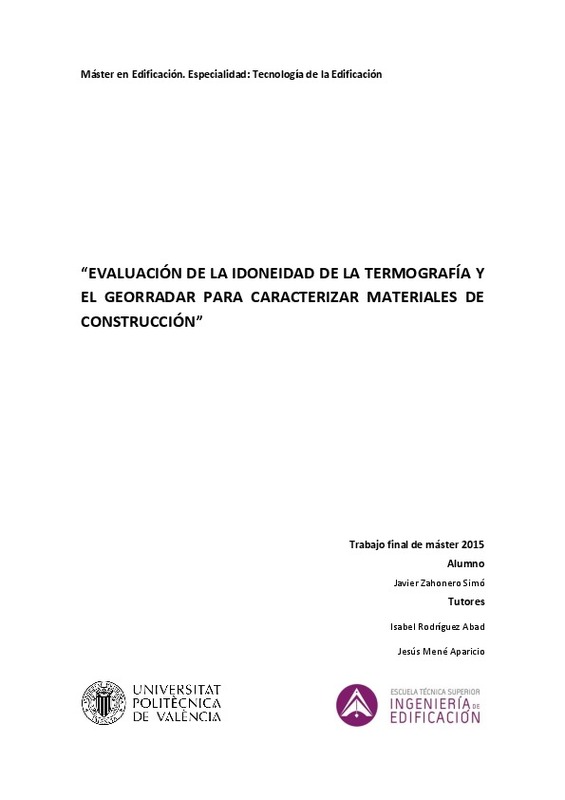JavaScript is disabled for your browser. Some features of this site may not work without it.
Buscar en RiuNet
Listar
Mi cuenta
Estadísticas
Ayuda RiuNet
Admin. UPV
Evaluación de la idoneidad de la termografía y el georradar para caracterizar materiales de construcción
Mostrar el registro sencillo del ítem
Ficheros en el ítem
| dc.contributor.advisor | Mené Aparicio, Jesús
|
es_ES |
| dc.contributor.advisor | Rodríguez Abad, Isabel
|
es_ES |
| dc.contributor.author | Zahonero Simó, Javier
|
es_ES |
| dc.date.accessioned | 2015-11-13T11:06:55Z | |
| dc.date.available | 2015-11-13T11:06:55Z | |
| dc.date.created | 2015-09-27 | |
| dc.date.issued | 2015-11-13 | |
| dc.identifier.uri | http://hdl.handle.net/10251/57447 | |
| dc.description.abstract | [ES] En la actualidad la aplicación de técnicas no destructivas en el área de caracterización materiales de construcción está proporcionando resultados muy prometedores. En esta investigación se evalua el potencial de la termografía infrarroja y georradar para la evaluación física de materiales de construcción. Mediante estas técnicas se pretende analizar el comportamiento de tres tipos de materiales de construcción (madera, hormigón y pétreos naturales) sometidos a diferentes ensayos, donde la densidad y la absorción de agua serán las características principales a evaluar. La densidad expresa la relación entre la cantidad de material y el volumen, proporciona información de la condición material y está estrechamente relacionada con otras propiedades físicas y mecánicas. Además, las patologías en muchos materiales de construcción son causadas por la pérdida de densidad, lo que lleva a un deterioro del material que podría causar la pérdida de su comportamiento estructural fiable. La absorción de agua, se define como la capacidad de un material de absorber un fluido a presión atmosférica, se determina mediante el coeficiente de absorción y también influye en el comportamiento físico-mecánico del material. Por todo lo anterior, en primer lugar en este trabajo se realiza un estudio sobre los fundamentos teóricos de la termografía infrarroja y el georradar. Dentro de los aspectos teóricos se hace una revisión sobre los principios matemáticos en los que se basa cada método. Después se revisan cuales son las características más relevantes de los equipos y cuáles son las variables que van a afectar de forma determinante en la obtención de los registros. La segunda parte del trabajo incluye el diseño experimental y los resultados e interpretación de los ensayos realizados. | es_ES |
| dc.description.abstract | [EN] Currently, the application of non-destructive techniques in the area of building materials characterization is providing very promising results. This research is focused on the analysis of the potential of infrared thermography and GPR for physical evaluation of different construction materials. The behavior of three types of construction materials (wood, concrete and natural stone) will be analysed by these techniques, where the density and water absorption are the main features to be estimated. Density provides information of the material condition and is closely related to other physical and mechanical properties. In addition, the pathologies in many building materials are caused by the loss of density, which leads to deterioration of material that could cause loss of reliable structural behavior. Therefore, to be able to assess the density and its variation is of great importance when building materials are analyzed. The water absorption is defined as the ability of a material to absorb a fluid under atmospheric pressure. It will be defined by the absorption coefficient and also influences the material mechanical behavior. For all these reasons, a study of the theoretical concepts of infrared thermography and GPR was performed. Within the theoretical aspects, a review of mathematical principles in which every method is based, is detailed. After that, we reviewed what are the most important characteristics of the equipment and which variables will affect decisively in obtaining the records. The second part of the work includes the design and experimental results and interpretation of the results of the tests performed. | es_ES |
| dc.format.extent | 168 | es_ES |
| dc.language | Español | es_ES |
| dc.publisher | Universitat Politècnica de València | es_ES |
| dc.rights | Reconocimiento - No comercial - Sin obra derivada (by-nc-nd) | es_ES |
| dc.subject | Termografía | es_ES |
| dc.subject | Georradar | es_ES |
| dc.subject | Termografía infrarroja | es_ES |
| dc.subject | Ensayos no destructivos | es_ES |
| dc.subject | Ground penetrating radar | es_ES |
| dc.subject | Infrared imaging | es_ES |
| dc.subject | Nondestructive testing | es_ES |
| dc.subject | Thermography | es_ES |
| dc.subject.classification | CONSTRUCCIONES ARQUITECTONICAS | es_ES |
| dc.subject.other | Máster Universitario en Edificación-Màster Universitari en Edificació | es_ES |
| dc.title | Evaluación de la idoneidad de la termografía y el georradar para caracterizar materiales de construcción | es_ES |
| dc.type | Tesis de máster | es_ES |
| dc.rights.accessRights | Abierto | es_ES |
| dc.contributor.affiliation | Universitat Politècnica de València. Escuela Técnica Superior de Gestión en la Edificación - Escola Tècnica Superior de Gestió en l'Edificació | es_ES |
| dc.description.bibliographicCitation | Zahonero Simó, J. (2015). Evaluación de la idoneidad de la termografía y el georradar para caracterizar materiales de construcción. Universitat Politècnica de València. http://hdl.handle.net/10251/57447 | es_ES |
| dc.description.accrualMethod | Archivo delegado | es_ES |
| dc.subject.asignatura | Ensayos y técnicas no destructivas aplicadas en la diagnósis de las construcciones históricas 34223 / B - Máster universitario en conservación del patrimonio arquitectónico 2162 | es_ES |
Este ítem aparece en la(s) siguiente(s) colección(ones)
-
ETSIE - Trabajos académicos [2341]
Escuela Técnica Superior de Ingenieria de Edificación






